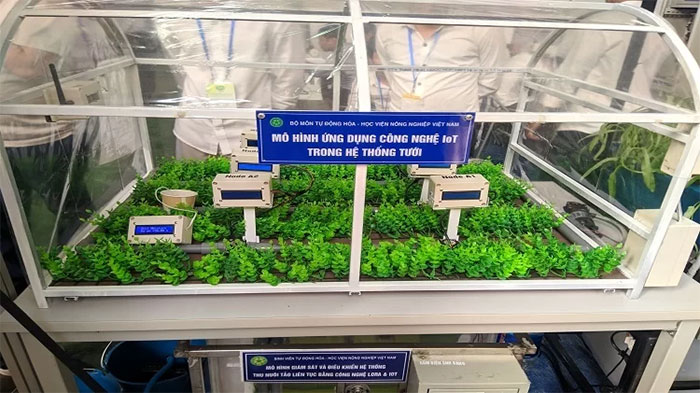Students design an automatic watering system when plants 'thirst' for water
Sensors are installed in the system to identify the problem tree position, automatically irrigate and notify garden owners.
At the end of 2017, when practicing at a crop farm in Israel, Do Ngoc Minh, a student of the Faculty of Automation, Vietnam National University of Agriculture was surprised that the staff here did not need to come down to the farm but still knew well. Water pipes in the area are broken and any garden is not watered enough. Learn new here has applied automation control technology in irrigation . Returning to the country, Minh talked with teachers and some engineers to learn more about IoT technology, wireless sensors, modeling and putting them into irrigation systems.
The idea quickly came true after only a year. In April 2019, the research team installed experiments in tomato gardens in the Academy to show the difference. Tomato gardens are equipped with an automatic irrigation system with an increase in sprouting and sprouting rates of 5%, and the plant's resistance to pests is also improved compared to traditional irrigation.

Automatic irrigation model applying IoT technology.(Photo: NX).
When designing the system, the research team applied specialized knowledge of automation and, thanks to the advice of agricultural engineers, used wireless sensors placed in many different positions. The sensor consists of boards, control modules and modules connected to the information management system on the phone or computer. Sensor position will be calculated and installed in places where water pressure is not stable."The hardest part is figuring out how to connect the sensors so that the model can work quickly and optimally. A single sensor malfunction can lead to the error of irrigation water pressure , " the chief said. shared research team.
These difficulties have been overcome, the design system has improved the accuracy of irrigation time and amount of water by automation technology, towards smart agriculture. The sensor monitors the amount of water entering and leaving the garden, identifying the location of a problem tree. In case of insufficient water supply for the crop, the sensor will notify the phone and ask the user to start the irrigation system. The system also automatically alerts the signal to lock the water valve after reaching the designed humidity.
To commercialize the product, the team plans to introduce the system to some growers. If feasible, the group will plan to apply for support from an IoT technology company to assemble on a large scale. The team also cherished designing an early detection software for plant pests with image processing. The software will process the image of the crop with input data that is pre-installed on the phone or computer, helping the garden owner to find out the cause of the damage, thereby reducing the cost of care.
- Automatic Droplet Robot watering each tree
- Students of automatic antenna design
- The group of students uses 'bottle' as an automatic seal machine
- Invented from shrimp ponds of 3 students
- How do Americans cope with drought?
- Stunned hypothesis, Mamut elephant extinct because of thirst?
- Decipher the mystery of thirst: Why does it form and why does it disappear?
- When thirsty, swallow saliva is less thirsty?
- Mistake when waiting for thirst to drink water
- Automatic heat sensing system for nursing seedlings
- Water-saving technology saves time
- Earthquake-resistant design
 'Barefoot engineer' invents a pipeless pump
'Barefoot engineer' invents a pipeless pump Process of handling dead pigs due to disease
Process of handling dead pigs due to disease Radiometer
Radiometer Warp Engine: Technology brings us closer to the speed of light
Warp Engine: Technology brings us closer to the speed of light